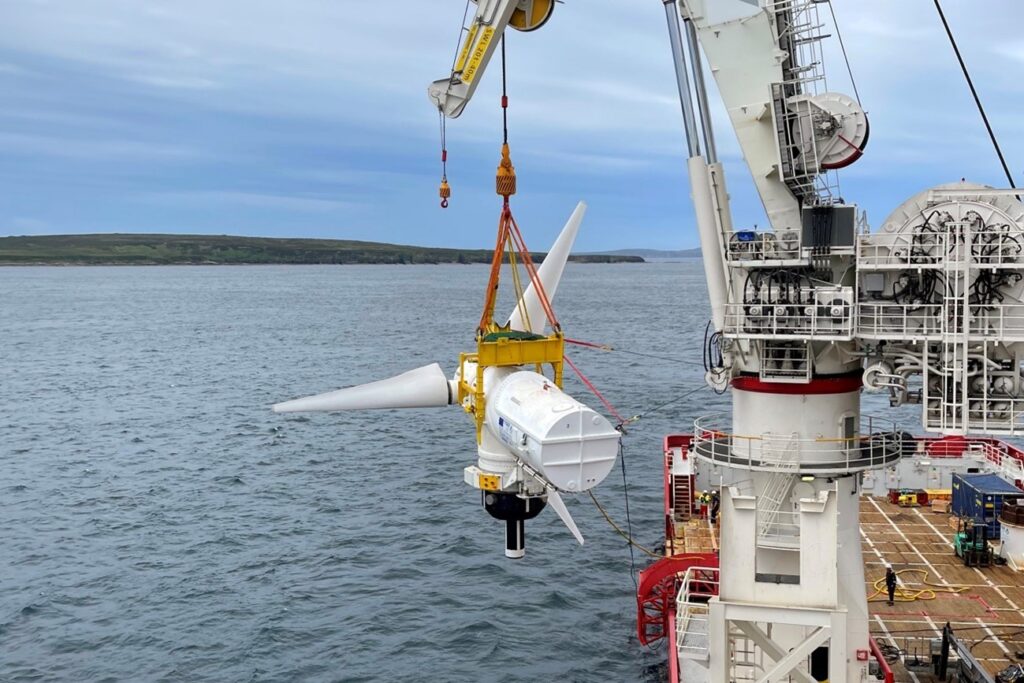
A turbine is lowered into the water at the MeyGen Tidal Power Project in Scotland. When completed, MeyGen will nearly double the renewable energy output of the largest tidal power plant in the world today. Image: DeepOcean.
By James Myers
An immense amount of energy is stored in the oceans, and with technological advances waves and tides are now delivering an important source of renewable power in the quest to replace fossil fuels.
More than two-thirds of the Earth’s surface, about 71%, is covered in water and 96.5% of that water is found in the oceans. While patents for water-powered devices have existed for over two centuries, a renewed focus on water power generation which was sparked by combined crises in energy and the climate is taking water power to new and very promising frontiers.
The tremendous amount of energy stored in ocean waves and tides is the focus of innovative new processes and large-scale projects to harness, convert, and deliver the power efficiently for industrial and home use in a world hungry for renewable energy.
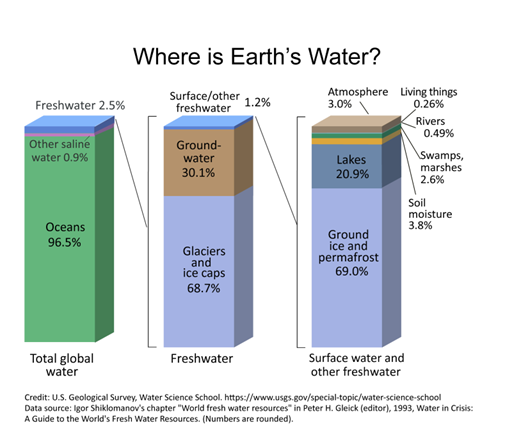
Image U.S. Geological Survey
The fact that the majority of the global population lives near coastlines makes ocean energy a particularly attractive source to replace fossil fuels and other polluting and non-renewable sources of power.
The Maritime Affairs and Fisheries division of the European Commission states that “Wave energy is the single largest unused renewable energy source on the planet.” With a theoretical potential to produce 30,000 terawatt hours of energy annually, it would more than meet present worldwide electrical consumption. Not all of the ocean’s energy can be exploited, however, given the inaccessibility of many locations and technological constraints. Some estimate that between 5% and 10% of the potential could be converted to electricity.
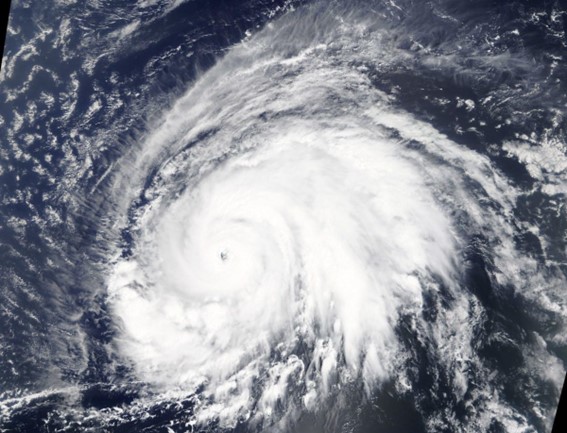
The force of the ocean’s energy is evident in a hurricane. Satellite image of September 2019 category 5 Hurricane Lorenzo from NASA.
The amount of potential energy in the oceans is difficult to measure reliably, either globally or in specific areas where wave and tidal energy is particularly forceful. Regardless, the immense force of ocean energy is clearly demonstrated in a hurricane, which draws heat from tropical air and releases the thermal energy by condensing water vapour into rain. It’s estimated that an average hurricane produces energy equal to 200 times the world’s annual electrical generation capacity in its rain and clouds, and 50% of current annual capacity in its winds.
To aid in planning for large-scale wave and long-term and tidal energy projects, the U.S. Department of Energy’s National Renewable Energy Laboratory is developing methods to measure the potential energy of oceans more accurately. In a 2023 study, researchers combined many variables, including the direction of waves, onshore and offshore sources of wave-driving winds, and distance travelled from source, to develop a model that “works for all scales – from the very small, single-project scale all the way to the entire ocean basin,” according to lead author Levi Kilcher.
In data sets gathered to assess the United States’ wave energy potential, the researchers noted a bias in the variables used to estimate the power stored in ocean waters. While the bias could mean earlier estimates are inflated between 25% to 40%, the total available is nonetheless vast. Since technological and cost constraints mean that only a portion of the energy can be harvested for use, “The practical resource is probably a small percentage of the theoretical resource,” Kilcher said. “But because there is so much wave energy out there, it’s still an important resource.”
New projects in wave and tidal energy are important contributors to global renewable energy mandates.
Affordable and clean energy is one of the United Nations’ 17 Sustainable Development Goals. Noting that that energy is the major cause of climate change, the UN observes that “At the current pace, about 660 million people will still lack access to electricity and close to 2 billion people will still rely on polluting fuels and technologies for cooking by 2030.”
The energy sector is responsible for more than three-quarters of greenhouse gas emissions in the 27 member states of the European Union. The EU’s aim is to become “climate-neutral” by 2050 and last year the union adopted a binding target for 42.5% of its energy production from renewable sources by 2030, nearly doubling the amount produced in 2022. Tidal, wave, and other ocean energy sources are expected to contribute at least 1 gigawatt of capacity by 2030 and expand to 40 GW by 2050.
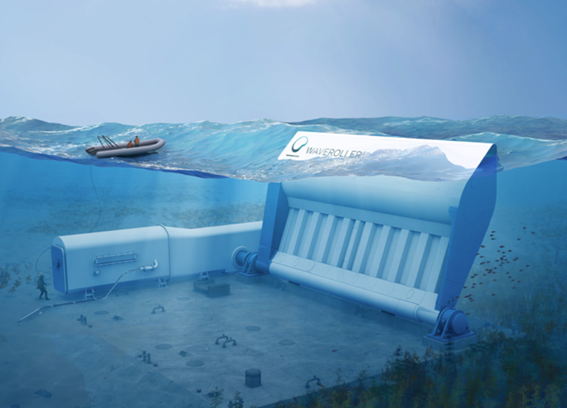
Illustration of AW-Energy’s WaveRoller technology, now operating near Peniche, Portugal. Installed from 0.3-2 km from shore where the wave surge is strongest, a single panel anchored at 8-20 metres of depth can produce between 350 KW-1000 KW of electricity. Image: AW-Energy
This July, EU member Portugal adopted a more ambitious target of 85% renewable energy production by 2030. With approximately 943 kilometres of coastline on its continental mainland and a similar amount in its Azores and Madeira archipelagos, Portugal is particularly well positioned to exploit ocean energy.
Finland-based AW-Energy’s WaveRoller technology has been installed near Peniche, Portugal. WaveRoller consists of electrical-generating panels placed between 0.3 kilometres to 2 kilometres from the shore where the wave surge is strongest. Anchored at between 8 to 20 metres of depth, a panel can produce up to 1000 kilowatts of electricity. The company has received funding from the EU’s WaveFarm project to implement arrays of 10 to 24 panels in multiple locations.
Publicly-traded Eco Wave Power has received approval to begin construction of a wave energy capture facility in Porto, Portugal. Beginning with 1 megawatt of energy production that will eventually expand to 20 MW, the facility will feature an underwater wave energy museum and education centre for the public.
Large-scale tidal energy facilities are increasing globally.
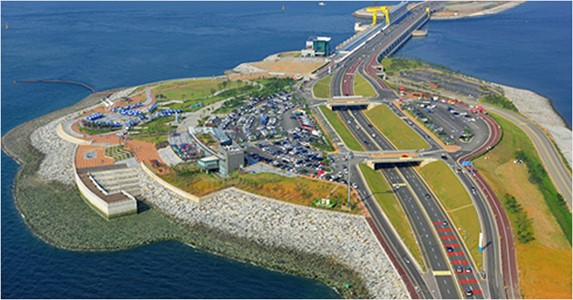
The Sihwa Lake Tidal Power Plant in South Korea is currently the world’s largest tidal power generator, capable of producing 254 MW of power. Image: K-Power
The world’s largest tidal wave facility is currently in South Korea. Its electrical output will soon be eclipsed by one under development in Scotland.
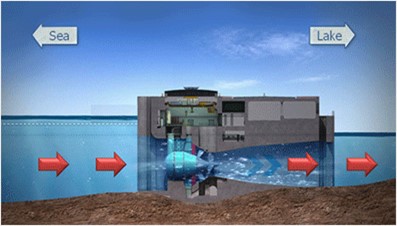
The exchange of lake and sea water drives the electricity-producing turbines in the Sihwa Lake Tidal Power Plant. Image: K-Power
Beginning operation in 2011, the Sihwa Lake Tidal Power Plant in South Korea is capable of producing 254 megawatts of power which government-owned K-Water, responsible for its management, states is sufficient to supply electricity to 500,000 people.
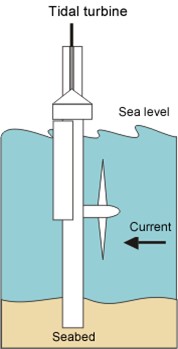
Image from the U.S. Energy Information Administration.
The Sihwa Lake facility reduces petroleum requirements by 862,000 barrels per year and avoids 315,000 tons annually of CO2 emissions that would contribute to global warming. A further benefit is that the plant was constructed at the mouth of a lake suffering extreme pollution, and the nine-metre tidal range not only provides a constant and reliable source of power but the water flowing between the sea and lake has rehabilitated and restored life to the lake.
The power generated at Sihwa Lake will soon be eclipsed by the 398 MW MeyGen Tidal Power Project under construction in the Inner Sound of the Pentland Firth, in Scotland. MeyGen will nearly double the electrical generation and environmental benefits of Sihwa.
MeyGen is being constructed in three phases.
Part of the first phase was commissioned in 2018 producing 6 gigawatt hours of electricity, which was increased to 37 GWh over the following two years. As phases 2 and 3 of MeyGen begin construction, the project’s effects on the water, marine wildlife, and the surrounding environment are being closely monitored.
In February, 2023 MeyGen owner Simec Atlantis Energy (SAE) announced that the facility had generated the world’s first 50 GWh of energy from a tidal stream array. The array’s electricity-generating turbines are situated 20 metres below the water’s surface, at a narrow point in the Firth of Pentland where the waters of the North Sea and North Atlantic exchange.
In September 2023, SAE received an power price guarantee extending for 15 years from the expected date in March 2028 when another 50 MW of electrical production is expected to come online in the next phase of the MeyGen project. The rate guarantee will allow the company to generate financing to fund the cost of expansion.
Wave energy operates not by the flow of water through a barrier but by bobbing pistons.
Instead of tidal waves flowing past a turbine that generates electricity, ocean power can also be captured by independent devices floating on the surface of the water.
Sweden-based CorPower Ocean AB has developed a buoy containing pistons that drive an electrical generator. The pistons are moved by the bobbing of the buoy on the surface of the water, thus harnessing the kinetic energy of waves and converting it to electrical energy.
CorPower’s technology is an example of one type, called a point absorber, of wave energy power generation.
A point absorber captures the motion of the waves from multiple directions, however there are other options to harness wave power.
For one, there are attenuators, which are placed parallel to the direction of the waves to capture the direction of motion. There are also oscillating water columns, which use the rising and falling motion of the waves to compress and decompress air within a chamber driving a turbine. Additionally, there are overtopping devices to guide waves into a raised reservoir which is then released to drive a turbine. Yet another type (of which the WaveRoller discussed above is an example) operates by submerged pressure differential.
Is the future in the water?
As the technology continues to develop, a significant barrier to a more widespread implementation of tidal and wave power generation is the cost of the equipment and construction, which is particularly challenging in water. The prohibitive cost means that a large capacity, for example 1 GW, has to be installed to achieve an economy of scale. There are currently few businesses and governments with the human and economic resources to invest in ocean energy development, given its risks as well as the opportunities of alternatives.
In spite of the challenges, the immense energy potential of the oceans that cover more than two-thirds of our planet is an increasingly attractive investment for a sustainable and predictable source of power. The belief that stakeholders have placed in the MeyGen Tidal Power Project, which will nearly double the world’s largest ocean power installation, is a sign of the good times to come for our ability to harness electricity from the oceans.
We would love to hear what you think of this article.
☞ Click here to complete our 2-minute Reader survey.
Craving more information? Check out these recommended TQR articles:
- Progress in Superconductivity Holds Promise for Clean Energy, Medicine, Quantum Computing, and More
- Advances in Nuclear Fusion Technology are Fueling the Dream of Limitless Clean Energy
- Clean Technologies and Technologies That Clean: Undoing the Climate Damage We Have Caused
- Harnessing Ocean Power: New Technologies Hold Promise for Clean and Cost-Effective Energy
- In Wiki Loves Earth Photos, Observers Share a Deep Knowledge of Nature’s Incredible Integration



